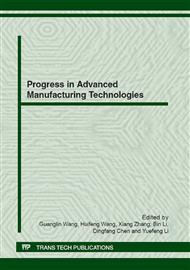p.152
p.156
p.162
p.167
p.173
p.178
p.183
p.187
p.192
Study on Residual Stress of GCr15 Bearing Steel under Ultrasonic Vibration Turning
Abstract:
The effects of the cutting parameters on residual stresss were investigated in common and ultrasonic vibration hard turning bearing steel GCr15 with PCBN. The residual stresses under the machined surface were measured by X-ray diffraction technique. The results obtained in this study show that residual compressive stress is produced both in common and ultrasonic turning of GCr15 bearing steel. Under the same turning condition the residual compressive produced by the ultrasonic turning is smaller than that by the common turning. Residual compressive stress can improve the fatigue performance and life of workpiece, so the cutting parameters should be optimized to get the best residual compressive stress in ultrasonic turning.
Info:
Periodical:
Pages:
173-177
Citation:
Online since:
August 2012
Authors:
Keywords:
Price:
Сopyright:
© 2012 Trans Tech Publications Ltd. All Rights Reserved
Share:
Citation:


